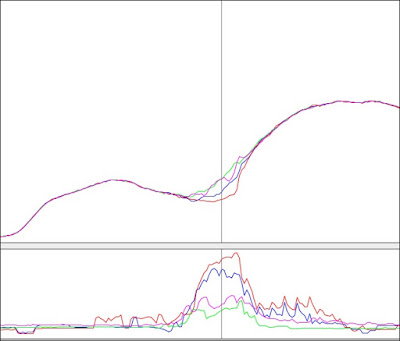I had to pick up a sail that Bob had repaired at the other end of Corpus Christi, so I put three GW-60 watches on the dashboard, and added two phones with USB GPS dongles. I analyzed the results by exporting the speed results from GPSResults, importing them into a spreadsheet, and comparing the top 10 individual speeds in various categories. . Here is what that looked like for the 10 second category:
That's a lot of numbers, so let's look at the differences instead. The next table shows the differences for each number relative to the average of the numbers I got for 2 GW-60s run at 5 Hz, the current "gold standard":
The three rows at the bottom show the average difference for each device, the standard deviation of the differences, and the maximum absolute observed difference in the top 10 speeds.
So far, so good. The maximum observed differences are below 0.1 knots, the typical differences even smaller - that great accuracy. The numbers for several other categories looked similar, but for the 500m category, one of the top-10 results showed much larger differences:
For the 9th value, the dongles reported speeds that were 0.2-0.4 knots higher than what the GW-60s reported - that's a cause for concern. Here are the 500m speeds:
The numbers that appear to be the outliers are highlighted in red. Note, however, that this is based on the assumption that the GW-60 numbers are correct. I examined the traces for the 500m region in question, and observed something peculiar at the start:
The top part of the graph shows doppler speed, the lower part shows accuracy estimates (SDoP). The GW-60s are shown in blue and red, the USB dongles in green and magenta. The GW-60s have much higher error estimates in this region:
Here is a map view of this start region:
You can see a few things in the image. The "high error" region was when I took a left turn off the highway, and had to drive under the highway, which blocked the GPS signal. Apparently, the GW-60 was more affected by this than the USB dongle; this is in line with previous observations that the watch is more sensitive towards poor GPS reception. You can also see that this 500 m run has low speeds both at the beginning and the end. Because of this, the "understated" speed from the GW-60s at the beginning has a large effect on the average speed over 500 meters, since the region has to be extended by including more low-speed data at the end.
The bottom line from this test: overall, the results from the USB dongles are very similar to the GW-60s, with observed differences below 0.1 knots for most categories. In the one case where the differences were substantially larger, there are multiple indications that the USB dongles gave more accurate speeds than the GW-60, probably because the u-blox chip and antenna in the dongle handle situations of poor GPS signal strength better than the GW-60. This example also underscores the usefulness of accuracy estimates (SDoP values), although it also indicates that the currently used thresholds of 3.0 to 4.0 may be too high.












